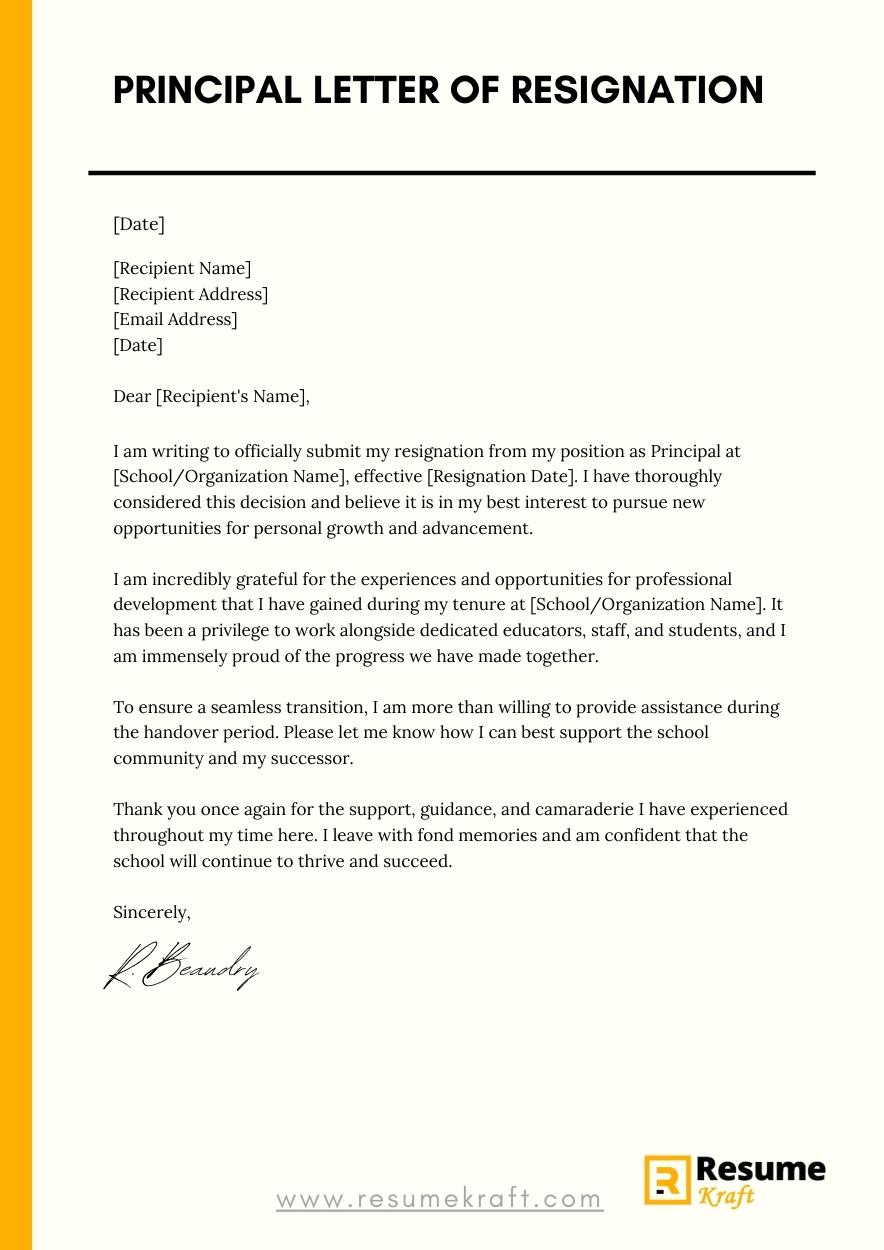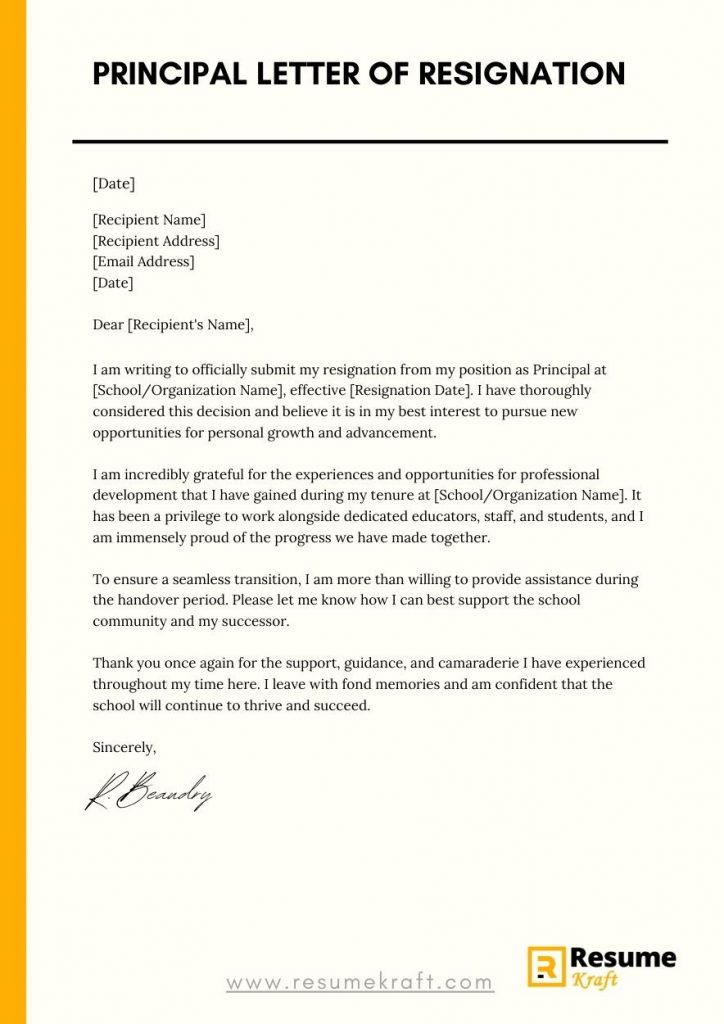
Leaving a position as a principal is a significant decision that requires the proper communication and documentation. One of the most crucial steps in this process is writing a well-crafted principal letter of resignation. This letter serves as a formal notification to your superiors, colleagues, and staff about your intent to resign.
In this guide, we will walk you through the essential elements to include in your principal letter of resignation, what not to include, how to format it effectively, and provide you with some samples to help you get started.
What To Include in Your Principal Letter of Resignation
When writing your principal letter of resignation, it is important to include the following key elements:
- Salutation: Begin your letter by addressing it to your direct supervisor or the appropriate recipient in a formal manner, such as “Dear [Supervisor’s Name].”
- Statement of Resignation: Clearly state your intention to resign from your position as a principal. Make sure to include the specific date of your resignation and adhere to any notice period required by your contract or organization.
- Reason for Resignation (Optional): While not mandatory, it can be beneficial to provide a concise explanation for why you have made the decision to resign. However, remember to keep it professional and positive, focusing on personal growth or career advancement rather than any negative aspects.
- Express Gratitude: Take the opportunity to express gratitude towards your colleagues, staff, and the organization as a whole. Highlight any valuable experiences, opportunities for growth, or lessons learned during your time as a principal.
- Offer Assistance: Offer your assistance during the transition period to ensure a smooth handover of responsibilities. This gesture demonstrates professionalism and a commitment to supporting your colleagues after you leave.
- Closing: End the letter formally with a closing remark, such as “Sincerely” or “Best Regards,” followed by your full name and contact information.
What Not to Include in Your Principal Letter of Resignation
While including specific elements is crucial, there are certain things you should avoid including in your principal letter of resignation:
- Negative Remarks: It is important to maintain a positive and professional tone throughout your letter. Avoid including any negative remarks, complaints, or criticisms about individuals or the organization.
- Excessive Details: Keep your letter concise and to the point. Avoid including excessive personal or professional details that are not directly relevant to your resignation.
- Resignation Discussion: It is not necessary to engage in a detailed discussion about your decision to resign or personal circumstances leading to it. This information can be discussed in person if required.
- Promises or Guarantees: Avoid making promises or guarantees about the future, such as promises to return, unless you are genuinely considering it and have discussed it with the appropriate individuals.
How To Format a Principal Letter of Resignation
To ensure your principal letter of resignation looks professional and is easy to read, follow these formatting guidelines:
- Use a Business Letter Format: Format your letter in a professional business letter format, with your contact information, date, recipient’s name, and address at the top left, followed by a salutation.
- Keep the Letter Concise: Aim to keep your letter to one page or less. Use clear, direct language to convey your message.
- Use Formal Language: Write in a formal tone and avoid using slang or casual language.
- Proofread for Errors: Double-check your letter for any spelling, grammar, or punctuation errors before sending it.
- Print and Sign it: If possible, print the letter and sign it by hand for a personal touch. If sending the letter via email, include a scanned copy of your signature or type your name.
Principal Letter of Resignation Sample
Here is a sample of a principal letter of resignation that you can use as a reference:

Printed Resignation Letter Sample
[Your Name]
[Your Address]
[City, State, Zip]
[Email Address]
[Phone Number]
[Date]
[Recipient’s Name]
[Recipient’s Position]
[School/Organization Name]
[Address]
[City, State, Zip]
Dear [Recipient’s Name],
I am writing to officially submit my resignation from my position as Principal at [School/Organization Name], effective [Resignation Date]. I have thoroughly considered this decision and believe it is in my best interest to pursue new opportunities for personal growth and advancement.
I am incredibly grateful for the experiences and opportunities for professional development that I have gained during my tenure at [School/Organization Name]. It has been a privilege to work alongside dedicated educators, staff, and students, and I am immensely proud of the progress we have made together.
To ensure a seamless transition, I am more than willing to provide assistance during the handover period. Please let me know how I can best support the school community and my successor.
Thank you once again for the support, guidance, and camaraderie I have experienced throughout my time here. I leave with fond memories and am confident that the school will continue to thrive and succeed.
Sincerely,
[Your Full Name]
[Your Contact Information]
Email Resignation Letter Example
If you prefer to send your resignation letter via email, here is an example:
Subject: Resignation – [Your Name]
Dear [Recipient’s Name],
I hope this email finds you well. I am writing to formally resign from my position as Principal at [School/Organization Name], effective [Resignation Date]. Please accept this email as my official notice.
I have deeply reflected on this decision and believe that it is the right time for me to explore new challenges and diversify my career experiences. I am grateful for the trust and support that I have received during my tenure at [School/Organization Name].
I am committed to facilitating a smooth transition for my successor and the school community. Please let me know how I can be of assistance during this period.
I would like to express my sincere gratitude to the entire staff and school community for their collaboration and dedication to providing an exceptional education to our students. It has been an honor to work alongside such talented and passionate individuals.
Thank you for your understanding and support throughout this process. I am confident that [School/Organization Name] will continue to succeed and positively impact the lives of its students.
Best Regards,
[Your Full Name]
[Your Contact Information]
Key Takeaways
Writing a principal letter of resignation requires careful thought and consideration. To summarize:
- Include essential elements such as a clear statement of resignation, gratitude, and an offer of assistance.
- Avoid negative remarks or excessive personal details.
- Use a professional letter format and proofread your letter before sending.
- Provide a concise explanation for your resignation, if desired, focusing on personal growth rather than negativity.
- Express gratitude towards your colleagues, staff, and the organization as a whole.
Frequently Asked Questions
1. Should I mention the reason for my resignation in the letter?
While it is optional, mentioning the reason for your resignation can provide some context. However, ensure you maintain a positive and professional tone and focus on personal growth or career advancement.
2. Is it necessary to print and sign the resignation letter?
If possible, printing and signing the letter by hand adds a personal touch. However, if you are sending an email, you can include a scanned copy of your signature or type your name.
3. What is the ideal length for a principal letter of resignation?
Aim to keep your letter to one page or less. Be concise and use clear, direct language to convey your message effectively.
4. Should I make promises or guarantees about the future in my resignation letter?
It is generally advisable to avoid making promises or guarantees about the future, such as promises to return, unless you have genuinely considered it and discussed it with the appropriate individuals.
5. Should I discuss my decision to resign in detail in the letter?
It is not necessary to engage in a detailed discussion about your decision to resign or personal circumstances leading to it. This kind of information is best discussed in person if required.
Conclusion
Writing a well-crafted principal letter of resignation is vital when it comes to leaving your position professionally and maintaining positive relationships with your colleagues and staff. By following the guidelines and utilizing the samples provided, you can ensure that your resignation letter reflects your professionalism, gratitude, and commitment to a smooth transition.

